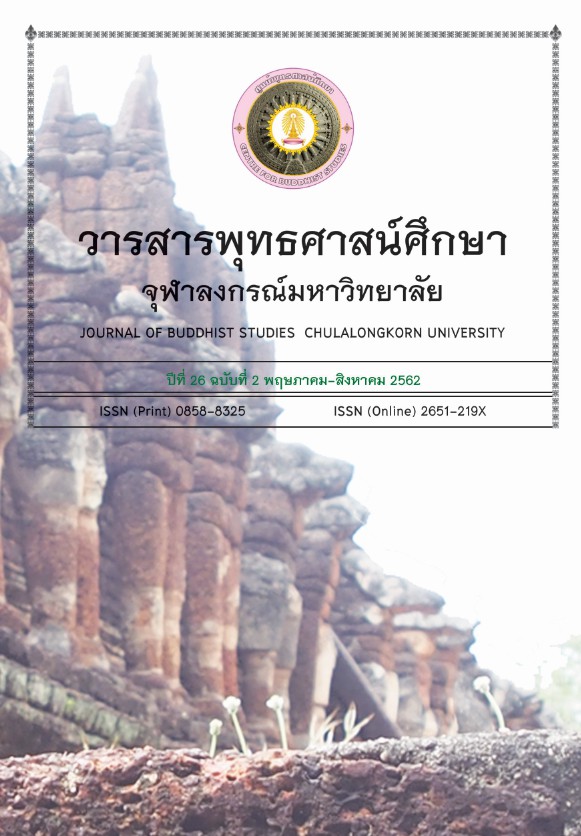consideration of the Buddhist monks’ samaṇasāruppa
Keywords:
samaṇasāruppa, consideration, Buddhist monkAbstract
This article aims to study the concept of samaṇasāruppa and the criteria for considering the samaṇasāruppa of Buddhist monks. The study finds that the term “samaṇasāruppa” refers to a set of criteria which consider not only bodily and verbal expressions (external samaṇasāruppa) but, more importantly, also mental qualities (internal samaṇasāruppa) of Buddhist monks, especially those of noble persons (ariyapuggala). If a Buddhist monk can attain internal samaṇasāruppa or virtues fitting a monastic person, the external samaṇasāruppa will follow spontaneously.
In principle, laypersons may consider both internal and external samaṇasāruppa of monks. The criterion for considering internal samaṇasāruppa is the level of monks’ mental ability in eliminating fetters (saṁyojana). The consideration of the external samaṇasāruppa has to refer to precepts and practical traditions of Buddhist monks. In the case of the complex actions, one should also refer to the 4 groups of basic criteria which facilitate monks’ attainment of the ultimate goal of Buddhism. These include: 1) Being easy to support, 2) Wanting little, being content, and not hoarding, 3) Being fond of solitude, free of defilements, and respectable, and 4) Being secluded and exerting.
In practice, although laypersons can consider the external samaṇasāruppa of Buddhist monks, it is more difficult to consider their internal samaṇasāruppa due to two limitations. These are: 1) the epistemic limitation in determining whether a monk is a noble person, and if so, at which level, and 2) the limitation of knowledge of the Buddhist monks’ codes of monastic disciplines. Therefore, in considering the samaṇasāruppa of Buddhist monks, a laity should keep these two limitations in mind. Besides, such consideration should be done without bias for the sake of cautiousness and fairness, which will in the end benefit the development of Buddhist monk’s samaṇasāruppa.
References
พระพรหมคุณาภรณ์ (ป. อ. ปยุตฺโต). (2553). พจนานุกรมพุทธศาสตร์ ฉบับประมวลธรรม. นนทบุรี : เพิ่มทรัพย์การพิมพ์.
พระพรหมคุณาภรณ์ (ป. อ. ปยุตฺโต). (2551). พจนานุกรมพุทธศาสน์ ฉบับประมวลศัพท์. กรุงเทพฯ : มหาจุฬาลงกรณราชวิทยาลัย.
พระพรหมคุณาภรณ์ (ป. อ. ปยุตฺโต). (2556). โยนิโสมนสิการ – วิธีคิดตามหลักพุทธธรรม. สืบค้นจาก https://www.watnyanaves.net/uploads/File/books/pdf/yonisomanasikara_thinking_in_ways_of_buddhadhamma.pdf
มหามกุฏราชวิทยาลัย. (2534). พระไตรปิฎกพร้อมอรรถกถาแปล ชุด 91 เล่ม.กรุงเทพฯ: มหามกุฏราชวิทยาลัย.
มหามกุฏราชวิทยาลัย. (2470). พระไตรปิฎกภาษาบาลี ฉบับสยามรัฐ. กรุงเทพฯ: โรงพิมพ์พาณิชสรรพอุดม.
วศิน อินทสระ. (2545). ความสุขที่หาได้ง่าย. กรุงเทพฯ: สํานักพิมพ์เรือนธรรม.
สมเด็จพระพุทธโฆษาจารย์ (ป. อ. ปยุตโต). (2560). งานก็ได้ผล คนก็เป็นสุข. กรุงเทพฯ : สํานักพิมพ์อมรินทร์ ธรรมะ.
เสฐียรพงษ์ วรรณปก. (2543). พุทธศาสนา : ทรรศนะและวิจารณ์. กรุงเทพฯ: มติชน.
สํานักงานราชบัณฑิตยสภา. (2558). สมณสารูป. สืบค์นจาก https://www.royin.go.th/dictionary/
สัมภาษณ์
พระครูภาวนาวิสุทธิคุณ วิ. (ชัชวาล ชินสโภ). ประธานคณะกรรมการบริหารศูนย์กลางการศึกษาวิปัสสนาธุระพุทธวิหาร วัดพระธรรมจักร จังหวัดนครนายก. สัมภาษณ์, 5 กันยายน 2559.
พระไพศาล วิสาโล. เจ้าอาวาสวัดป่าสุคะโต จังหวัดชัยภูมิ. สัมภาษณ์, 22 กันยายน 2559.
Downloads
Published
How to Cite
Issue
Section
License
บทความที่ได้รับการตีพิมพ์เป็นลิขสิทธิ์ของศูนย์พุทธศาสน์ จุฬาลงกรณ์มหาวิทยาลัย
ข้อความที่ปรากฏในบทความแต่ละเรื่องในวารสารวิชาการเล่มนี้เป็นความคิดเห็นส่วนตัวของผู้เขียนแต่ละท่านไม่เกี่ยวข้องกับศูนย์พุทธศาสน์ จุฬาลงกรณ์มหาวิทยาลัย และคณาจารย์ท่านอื่นๆในมหาวิทยาลัยฯ แต่อย่างใด ความรับผิดชอบองค์ประกอบทั้งหมดของบทความแต่ละเรื่องเป็นของผู้เขียนแต่ละท่าน หากมีความผิดพลาดใดๆ ผู้เขียนแต่ละท่านจะรับผิดชอบบทความของตนเองแต่ผู้เดียว





